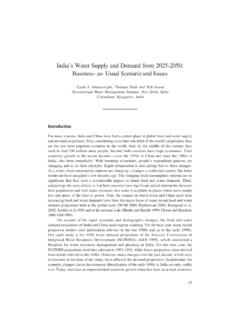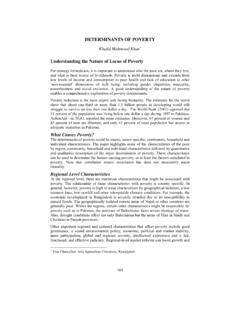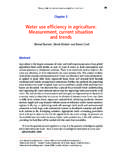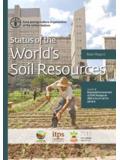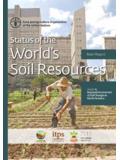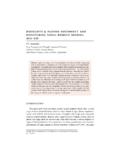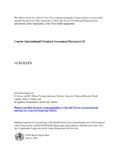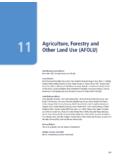Transcription of Impact Assessment of Rainwater Harvesting …
1 Impact Assessment of Rainwater Harvesting ponds : The Case of Alaba Woreda, Ethiopia Rebeka Amha ILRI, Addis Ababa, Ethiopia. Abstract statistically significantly. Results of analysis of qualitative information, consistent, with Rainfall in the arid and semi-arid areas is the Probit model results, also showed that generally insufficient to meet the basic labor requirement, economic problem to use needs of crop production. Thus, there is now simpler water lifting and watering increasing interest to the low cost alternative equipments, inability to easily understand generally referred to as water Harvesting ' the benefit of the technology and problems especially for small scale farming systems.
2 Related with the structure of the RWH. In Alaba, even if government efforts of technology adopted were some of the major household level water Harvesting schemes problems faced by households, and have a are wide spread, the performance obtained negative Impact on the technology adoption was not assessed. Due to this reason, there rate. was a need to asses the Impact of the existing Rainwater Harvesting systems in The Ordinary Least Square estimation of the Alaba Woreda. determinants of the value of crop production shows that adoption of RWH has a positive The study assesses the determinants of and statistically significant effect on value of households' adoption of Rainwater crop production, after controlling for input Harvesting ponds , and its Impact on use and other factors.
3 This shows that RWH. agricultural intensification and yield in ponds have direct and significant Impact on Alaba Woreda, southern Ethiopia. Results value of crop production. We also find that are based on data collected from a survey of households with RWH technology use more 152 households and 1036 plots operated by labor and seed but less oxen power the households. Households were stratified compared with those households who have into those with rain water Harvesting ponds not adopted the technology. Moreover, labor and those without from which equal number and seed inputs have positively significant of sample households ware drawn.
4 Analysis Impact on yield while the effect of oxen of descriptive information (mainly focusing power is insignificant. These results show on cropping pattern) and econometric that in addition to its direct Impact , RWH. methods are used. Analysis of qualitative has significant indirect Impact on value of information supplemented the econometric crop production through its effect on results. intensity of input use. The finding in the cropping pattern shows Labor requirements and cost considerations that, farm households have started to grow appear to be important factors that influence new crops (vegetables and perennial crops) household's adoption of RWH technology.
5 As a result of water availability from the This implies that research and development water Harvesting ponds . Results of Probit interventions need to take account of the analysis on the determinants of adoption of labor and cost demands of the technology. Rainwater Harvesting ponds shows that The effectiveness of the technology household size, education status of adoption is mainly constrained by problems household head, ownership of livestock related to water lifting and watering (cattle, oxen and pack animals), homestead equipments, and accidents occurring due to plots and type of pond explained adoption 223.
6 Absence of roof cover and fence to the than 90% of the total agricultural output and ponds . This implies that support will be cultivate close to 95% of the total cropped needed to provide affordable but improved land dominate the sector. Agricultural water lifting and watering equipments, and production is highly dependent on the give training to farm households on vagaries of nature with significant construction and use of roof covers and variability in production and actual fences to the ponds . As households shift to production patterns (Demeke et al, 2005).
7 High value but perishable commodities due to the RWH, emphasis needs to be given to Due to population increase in the highland marketing extension, especially in areas, more and more marginal areas are facilitating markets and market linkages to being used for agriculture which led to the farmers. degradation of the natural resources .One of the major challenges to rural development in Future intervention to promote RWH the country is how to promote food technologies need to provide due attention to production to meet the ever-increasing quality, rather than focusing on the number demand of the growing population.
8 Rainfall of adopters. Households appear to neglect in the arid and semi-arid areas is generally the community ponds since they focus on insufficient to meet the basic needs of crop using cleaner water obtained from production. In degraded areas with poor household ponds and other sources of clean vegetation cover and infertile soil, rainfall is water. In this process the community ponds lost almost completely through direct are becoming a cause of health problems. evaporation or uncontrolled runoff. Thus, Thus, it is important that appropriate overcoming the limitations of these arid and attention be given to the community ponds semi-arid areas and making good use of the as well.
9 Vast agricultural potential under the Ethiopian context, is a necessity rather than Finally, it was found out that women are a choice. Thus, there is need for appropriate getting benefit from the technology interventions to address the prevailing adoption as any member of the family. constraints using suitable technologies for Their participation in the technology improved and sustainable agricultural production. adoption is mainly in watching the ponds . They also have contribution in With regard to agricultural water planning and decision making stage, and development, small scale irrigation seems to in giving support during construction, be preferred to large scale schemes.
10 The maintenance and clearance of the pond. reason for the preference of small-scale Female headed households are being irrigation to large scale irrigation includes constrained to be beneficiaries due to the high capital requirement and cost of economic and manpower shortage. constructing large scale scheme which can only benefit a fortunate few but easy 1. Background adaptability of small scale irrigation (Turner, 1994). Ethiopia, like other Sub-Saharan African (SSA) countries, is an agrarian economy, There is now increasing interest to the low with a very small industrial sector.

